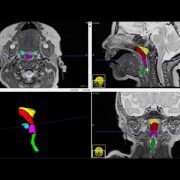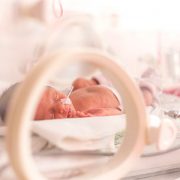A closer look at the placenta to predict FGR

Using three-dimensional magnetic resonance imaging, a Children’s National research team that included Catherine Limperopoulos, Ph.D., characterized the shape, volume, morphometry and texture of placentas during pregnancy and, using a novel framework, predicted with high accuracy which pregnancies would be complicated by fetal growth restriction.
Early in development, cells from the fertilized egg form the placenta, a temporary organ that serves as an interface between the mother and her growing offspring. When things go right, as occurs in the vast majority of pregnancies, the placenta properly delivers nutrients from the mother’s diet and oxygen from the air she breathes to the developing fetus while siphoning away its waste products. This organ also plays important immune-modulating and endocrine roles.
However, in a number of pregnancies, the placenta does not do an adequate job. Unable to effectively serve the fetus, a variety of adverse conditions can develop, including preeclampsia, fetal growth restriction (FGR), preterm birth and even fetal death.
Despite the key role that the placenta plays in fetal health, researchers have few non-invasive ways to assess how well it works during pregnancy. In fact, placental disease might not be suspected until very late.
In a new study, a team of Children’s National Health System research scientists is beginning to provide insights into the poorly understood placenta.
Using three-dimensional (3D) magnetic resonance imaging (MRI), the research team characterized the shape, volume, morphometry and texture of placentas during pregnancy and, using a novel framework, predicted with high accuracy which pregnancies would be complicated by FGR.
“When the placenta fails to carry out its essential duties, both the health of the mother and fetus can suffer and, in extreme cases, the fetus can die. Because there are few non-invasive tools that reliably assess the health of the placenta during pregnancy, unfortunately, placental disease may not be discovered until too late – after impaired fetal growth already has occurred,” says Catherine Limperopoulos, Ph.D., co-director of research in the Division of Neonatology at Children’s National Health System and senior author of the study published online July 22 in Journal of Magnetic Resonance Imaging. “Identifying early biomarkers of placental disease that may impair fetal growth and well-being open up brand-new opportunities to intervene to protect vulnerable fetuses.”
The Children’s research team acquired 124 fetal scans from 80 pregnancies beginning at the 18th gestational week and continuing through the 39th gestational week. Forty-six women had normal pregnancies and healthy fetuses while 34 women’s pregnancies were complicated by FGR, defined by estimated fetal weight that fell below the 10th percentile for gestational age. The placenta was described by a combination of shape and textural features. Its shape was characterized by three distinct 3D features: Volume, thickness and elongation. Its texture was evaluated by three different sets of textural features computed on the entire placenta.
“The proposed machine learning-based framework distinguished healthy pregnancies from FGR pregnancies with 86 percent accuracy and 87 percent specificity. And it estimated the birth weight in both healthy and high-risk fetuses throughout the second half of gestation reasonably well,” says the paper’s lead author, Sonia Dahdouh, Ph.D., a research fellow in Children’s Developing Brain Research Laboratory.
“We are helping to pioneer a very new frontier in fetal medicine,” Limperopoulos adds. “Other studies have developed prediction tools based on fetal brain features in utero. To our knowledge, this would be the first proposed framework for semi-automated diagnosis of FGR and estimation of birth weight using structural MRI images of the placental architecture in vivo. This has the potential to address a sizable clinical gap since we lack methods that are both sufficiently sensitive and specific to reliably detect FGR in utero.”
The research team writes that its findings underscore the importance of future studies on a larger group of patients to expand knowledge about underlying placenta mechanisms responsible for disturbed fetal growth, as well as to more completely characterize other potential predictors of fetal/placental development in high-risk pregnancies, such as genetics, physiology and nutrition.










